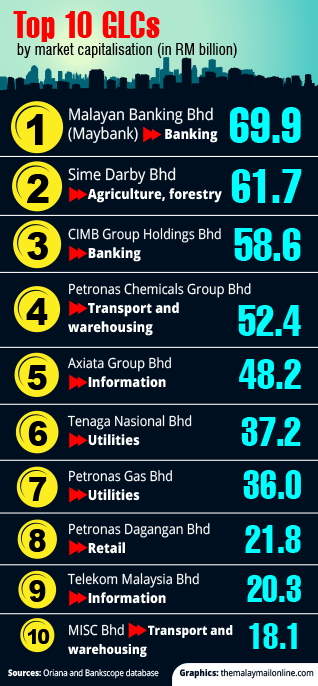GLC juggernaut crushing private enterprise, say analysts

Putrajaya estimates that firms linked to it employ around 5 per cent of the national workforce, and hold 36 per cent market capitalisation of Bursa Malaysia and 54 per cent of the Kuala Lumpur Composite Index (KLCI) respectively.
Zurairi AR and Ida Lim, The Malay Mail
Rich and powerful government-linked companies (GLCs) are “scaring” off private firms and stifling competition, analysts have said, despite Prime Minister Datuk Seri Najib Razak’s pledge of a more open economy with less state intervention
A steadily growing force since the Mahathir administration, GLCs such as Khazanah Nasional, Sime Darby and DRB-Hicom have amassed overflowing war chests and built networks that far surpass that which smaller firms and start-ups can muster.
From energy and property to cars and candy, ravenously expanding GLCs today seemingly have their fingers in every pie.
Putrajaya estimates that firms linked to it employ around 5 per cent of the national workforce, and hold 36 per cent market capitalisation of Bursa Malaysia and 54 per cent of the Kuala Lumpur Composite Index (KLCI) respectively.
“The work that we have done shows that when the GLC share of sales in an industry exceeds 60 per cent, there is a strong negative impact on private investment in that industry,” Jayant Menon, lead economist in trade and regional co-operation at Asian Development Bank (ADB), told The Malay Mail Online in an email interview here.
In April, together with fellow ADB economist Thiam Hee Ng, Menon released a paper, “Are Government-Linked Corporations Crowding out Private Investment in Malaysia?”, studying the growing influence of Malaysian GLCs.
In it, they suggested that foreign and local investment in Malaysia has remained lacklustre since the Asian financial crisis, since GLCs’ dominance have discouraged competition and entry of new private firms.

“The argument is that the GLCs (are) crowding out … when GLC is present in the market, it will scare others especially the small ones to be involved in the activity,” Malaysian Institute of Economic Research (MIER) executive director Dr Zakariah Abdul Rashid told The Malay Mail Online.
According to Menon, GLCs are prevalent in almost every sector, with the most dominant sectors being utilities (93 per cent), and transportation and warehousing (80 per cent). GLCs also control over 50 per cent of sectors such as agriculture, banking, information communications, and retail trade.
GLCs were established as part of the Barisan Nasional (BN) government’s affirmative action policies for Bumiputera citizens under the New Economic Policy (NEP), but its effectiveness has been questioned even by those it is meant to help ― Bumiputera entrepreneurs.
Last month, the Malay Chamber of Commerce Malaysia (MCCM) and the Malay Economic Action Council (MTEM) ― a consolidation of Malay economic organisations ― accused GLCs of failing to protect Bumiputera interests and sidelining Bumiputera firms instead.

“We believe that the implementation of the government’s policies has been weak, 1 Malaysia has not worked … Persons appointed to implement, the government-linked companies (GLCs) in particular, are weak,” MCCM president Datuk Syed Ali Al-Attas said in a media report.
The ADB paper asserted that GLCs have greater access to government procurement, hence find it easier to increase investment in sectors where they are already dominant. On average, GLCs have total assets almost nine times greater than non-GLCs, and are more likely to invest a higher proportion of their earnings.
Menon argued that Malaysia was also the only ASEAN country that is a net exporter of capital, claiming that total outflows have exceeded US$40 billion (RM124 billion) between 2006 and 2009, almost double that of inflows.
“Although some of this outflow is associated with Malaysian firms seeking better investment returns overseas, part of the outflow is almost certainly being driven by the crowding out factor at home due to GLCs,” said Menon.
But Zakariah maintained that such outflows need not necessarily be solely caused by domineering GLCs.
“That’s one of the reasons because you can’t really pinpoint that this is because of this. But that may be one of the things that contribute to that because the presence of GLCs will crowd out the activity of the private sector,” said Zakariah, who refused to put the blame solely on GLCs.
“GLCs are one of the many factors that cause the outflow but to blame the GLCs alone is not fair.”
Zakariah also said this was not yet a concern, believing that the government already has a plan to reduce the dominance of GLCs, especially with a competition policy.
Malaysia’s Competition Act 2010, which came into play last January and is enforced by the Malaysia Competition Commission (MyCC), seeks to discourage anti-competitive practices and monopolies in businesses.
Putrajaya had in recent years sought to decrease the role of GLCs in a bid to open up the market for private investors and businesses.
In July 2011, Pemandu chief executive officer Datuk Seri Idris Jala said the government will carry out a divestment exercise on 33 GLCs by selling 21 and listing seven of these companies, besides reducing its stakes in five of them.
Malaysia needs to increase its private investment to 20 per cent of its gross domestic product (GDP) by 2020 to reach a high-income nation status. Last year, Malaysia’s private investment increased to 15.5 per cent of GDP, its highest since 1998.

